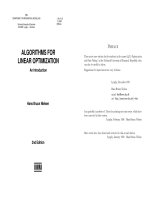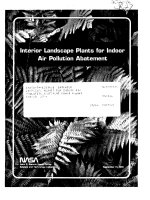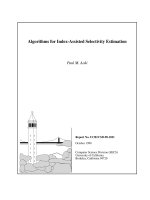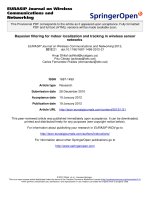Dead reckoning algorithms for indoor localization
Bạn đang xem bản rút gọn của tài liệu. Xem và tải ngay bản đầy đủ của tài liệu tại đây (8.72 MB, 165 trang )
DEAD RECKONING ALGORITHMS FOR
INDOOR LOCALIZATION
Submitted by
ZHANG YU
Department of Electrical & Computer Engineering
In partial fulfillment of the requirements for the
Degree of Master of Engineering
National University of Singapore
Jan 2012
i
Abstract
The recent development of smart phones and network has given rise to an increasing
demand of location based services which can be easily catered by Global Positioning
System (GPS) in outdoor environments, especially in rural areas. However, in urban
zones with tall buildings, and particularly in indoor environments, the GPS signals
are not reliable or even not available. To provide a reliable and robust localization
method for such environments, various technologies have been investigated by
researchers and engineers, such as dead reckoning method by steps counting, WLAN
fingerprinting, ultra-wide band method, Cricket, etc. In this project, three dead
reckoning algorithms (DRAs), DRA-I, DRA-II, DRA-III, have been proposed and
investigated.
Accelerometer and gyroscope are applied in Phase1 of DRA-I and is based on a strap
down technique to provide displacement direction. Given the displacement direction
from Phase1 and stride lengths estimated by step counting algorithm, Phase2
estimates the pedestrian’s position and velocity, which will then be provided to
Phase1 as measurements. Given an initial condition, it can accurately estimate the
pedestrian’s position for the first 10-15 meters. It then becomes dysfunctional
because DRA-I lacks a robust attitude estimation capability.
An attitude algorithm based on gyroscope, magnetometer and accelerometer has
been investigated. Although it provides acceptable estimation while the device is
stationary, estimation errors of the device’s roll and pitch angles have large errors if
the pedestrian is walking. It is adapted in DRA-II, which contains two steps. The
calibration step is to calculate the device’s initial state. The step tracking contains
ii
two phases. Phase1 is the same as that of DRA-I. Phase2 compares the device’s
status in the tracking mode and the initial state and estimate the device’s position and
velocity with the help of the step counting algorithm. As the device’s roll angle and
pitch angle are not accurately estimated, outputs of Phase1 are unsatisfactory, while
position estimations from Phase2 are accurate.
Attitude estimation can be further improved by applying the novel magnetometer
calibration proposed by [32], which is adapted in DRA-III. DRA-III indeed provides
better attitude and position estimation and is adequate to be implemented for real
time tracking purpose.
In summary, due to insufficient accurate attitude estimation, strap down techniques
are not adequate to use in pedestrians’ tracking problem. Instead, DRA-II and DRAIII, which estimate stride lengths by step counting algorithm, provide precise and
robust position estimations. They are not complete solutions for the indoor
localization problem, as correction technologies are not included. However, these
algorithms can be easily integrated into other technologies and therefore the effort
has built solid foundations for further extensions.
iii
ACKNOWLEDGEMENT
I would like to express my sincere gratitude to my supervisor Professor Lawrence
Wong, for his guidance and continuous support throughout the project. I was deeply
influenced by his enthusiasm, motivation and immense knowledge, which have
greatly inspired me.
Besides my supervisor, my sincere gratitude shall also be extended to Dr. Jin Yunye,
Phd Candidates Meng Xiaoli, Bao haitao, Wang Ke and Wang Lei for their valuable
advices and insightful comments.
I would also take this opportunity to express my appreciation to my lab mates, Song
Xianlin, Li Kang, and Guo Jie for their generous help, continuous support and
encouragement.
I wish to thank National University of Singapore for granting me the opportunity to
benefit from many erudite and warm-hearted professors.
In particular, I would thank my families who have always been supportive, patient
and encouraging.
iv
Abstract ......................................................................................................ii
ACKNOWLEDGEMENT ........................................................................ iv
List of Figures ..........................................................................................vii
List of Tables............................................................................................. ix
CHAPTER 1 INTRODUCTION ............................................................ 1
1.1
1.2
1.3
Introduction
.........................................................................................................................................
1
Literature Review
...............................................................................................................................
2
Project Objectives
..............................................................................................................................
8
CHAPTER 2 SYSTEM DESCRIPTON AND EXPERIMENTAL
METHODOLOGY ................................................................................... 9
2.1
Introduction to Platform
..................................................................................................................
9
2.1.1
Platform Requirements
........................................................................................................
9
2.1.2
Brief on Samsung Galaxy Tab
.......................................................................................
10
2.1.3
Android Platform
................................................................................................................
10
2.1.4
SensorManager API and WifiManager API
..............................................................
12
2.1.5
Introduction to Google App Engine
............................................................................
13
2.2
Global Coordinate Definition and Geomagnetic Field in the Test Laboratory
Environment
......................................................................................................................................................
14
2.2.1
Global Coordinate Definition
.........................................................................................
14
2.2.2
Geomagnetic Field in AMI lab
......................................................................................
14
2.3
Sensors Signal Analysis
.................................................................................................................
16
2.3.1
Accelerometer
.....................................................................................................................
16
2.3.2
Gyroscope
.............................................................................................................................
20
2.3.3
Magnetometer
......................................................................................................................
23
CHAPTER 3 PROPOSED DEAD RECKONING ALGORITHM - I26
3.1
Step Counting Algorithm
...............................................................................................................
26
3.1.1 Principles of Step Counting Algorithm
...............................................................................
27
3.1.2 Step Counting Algorithm in Real Time
..............................................................................
30
3.1.3 Experiment Results and Discussion
.....................................................................................
33
3.2 Overview of the Kalman Filter
...........................................................................................................
35
3.3 Proposed DRA-I
.......................................................................................................................................
37
3.3.1
Phase 1 Algorithm
............................................................................................................
38
3.3.2
Phase 2 Algorithm
..............................................................................................................
43
3.3.3 Wi-Fi fingerprinting
...................................................................................................................
44
3.4 Experiment Results
..................................................................................................................................
44
3.5 Discussion
...................................................................................................................................................
48
CHAPTER 4 PROPOSED DEAD RECKONING ALGORITHM - II49
4.1
Attitude Estimation Algorithm
.....................................................................................................
49
v
4.1.1
Algorithm Description
......................................................................................................
49
4.1.2
Experimental Results
........................................................................................................
54
4.2
Integrated Dead Reckoning Algorithm with Attitude Estimation
..................................
66
4.2.1
Algorithm Description
......................................................................................................
66
4.2.2
Experimental Results and Discussion
........................................................................
68
4.3
DRA-II
..................................................................................................................................................
71
4.3.1
Algorithm Description
......................................................................................................
71
4.3.2
Experimental Results
........................................................................................................
74
4.4 Discussion
...................................................................................................................................................
76
CHAPTER 5 PROPOSED DEAD RECKONING ALGORITHM III ............................................................................................................. 77
5.1 Magnetometer Calibration
...................................................................................................................
77
5.2 Accelerometer Calibration
...................................................................................................................
78
5.3 DRA-III
........................................................................................................................................................
79
5.3.1 Algorithm Description
..............................................................................................................
80
5.3.2 Experiment Results
....................................................................................................................
80
5.4 Discussion
...................................................................................................................................................
86
CHAPTER 6 CONCLUSION AND FUTURE WORK ...................... 87
6.1 Remark on Aforementioned Three DRAs
.......................................................................................
87
6.2 Recommendation for Future Work
....................................................................................................
88
REFERENCE ......................................................................................... 90
APPENDIX ............................................................................................. 94
APPENDIX 1 SAMSUNG TAB SPECIFICATION
.............................................................................
94
APPENDIX 2: MATLAB CODE FOR STEP COUNTING ALGORITHM
................................
96
APPENDIX 3: MATLAB CODE FOR DRA-I
......................................................................................
99
APPENDIX 4: MATLAB CODE FOR ATTITUDE ALGORITHM
...........................................
109
APPENDIX 5: MATLAB CODE FOR INTEGRATED ALGORITHM
....................................
113
APPENDIX 6: MATLAB CODE FOR DRA-II
..................................................................................
123
APPENDIX 7: NOVEL CALIBRATION ALGORITHM FOR MAGNETOMETER
............
133
APPENDIX 8: NOVEL CALIBRATION ALGORITHM FOR ACCELEROMETER
..........
141
APPENDIX 9: MATLAB CODE FOR DRA-III
................................................................................
146
vi
List of Figures
Figure 1. Top Smartphone Platforms Statistics
...........................................................................
11
Figure 2. Global Coordinate Definition
.........................................................................................
14
Figure 3. AMI Lab Geographical Location
...................................................................................
15
Figure 4. Static Test of Accelerometer's X-axis
..........................................................................
17
Figure 5. Static Test of Accelerometer's Y-axis
..........................................................................
18
Figure 6. Static Test of Accelerometer's Z-axis
..........................................................................
18
Figure 7. Static Test of Gyroscope's X-axis
.................................................................................
21
Figure 8. Static Test of Gyroscope's Y-axis
.................................................................................
21
Figure 9. Magnetometer X-axis Signals
.........................................................................................
23
Figure 10. Magnetometer Y-axis Signals
......................................................................................
24
Figure 11. Magnetometer X-axis Signals
......................................................................................
24
Figure 12: Accelerometer Output for 5 Steps with Pause in-between
.................................
28
Figure 13: Accelerometer Output for 5 Steps without Pause in-between
...........................
30
Figure 14: Step Result for 50 Steps’ Walking
.............................................................................
33
Figure 15: Step Counting Result for 50 Steps' Runing
............................................................
34
Figure 16: Step Counting Result for Descending From Staircases
.......................................
34
Figure 17: Relationship between Phase 1 and Phase 2 of DRA-I
.........................................
38
Figure 18: Straight Walking Test
.....................................................................................................
45
Figure 19: Turning Test
.......................................................................................................................
46
Figure 20: Static Rotation Test
..........................................................................................................
47
Figure 21: Static Case Test Yaw Angle Error
..............................................................................
55
Figure 22: Static Case Test Pitch Angle Error
.............................................................................
55
Figure 23: Static Case Test Roll Angle Error
...............................................................................
56
Figure 24:Walking Test Roll Angle Error
.....................................................................................
58
Figure 25: Walking Test Pitch Angle Error
..................................................................................
58
vii
Figure 26: Yaw Angle in Walking Test
........................................................................................
59
Figure
27:
Walking
Case
Gyroscope
X-‐axis
Output
...............................................................
60
Figure 28: Walking Case Gyroscope Y-axis Output
.................................................................
61
Figure 29: Walking Case Gyroscope Z-axis Output
..................................................................
61
Figure 30: Supplementary Test Accelerometer X-axis Output
..............................................
63
Figure 31: Supplementary Test Accelerometer Y-axis Output
..............................................
63
Figure 32: Supplementary Test Accelerometer Z-axis Output
...............................................
64
Figure 33: Supplementary Test Pitch Angle Errors
...................................................................
65
Figure 34: Supplementary Test Roll Angle Errors
.....................................................................
65
Figure 35: Waking Test of the Integrated Algorithm
................................................................
68
Figure 36: Waking Test of the Integrated Algorithm
................................................................
69
Figure 37: Waking Test with Strong Initial Magnetic Interference
......................................
69
Figure 38: Walking Test of DRA-II
................................................................................................
75
Figure 39: Walking Test for the DRA-II
.......................................................................................
75
Figure 40: Walking Test for DRA-II, Z-axis as Heading Direction
.....................................
76
Figure 41: Magnetometer calibration result
..................................................................................
78
Figure 42: Accelerometer Calibration Result
...............................................................................
79
Figure 43: Yaw Angle Estimation Errors of Static Case
..........................................................
81
Figure 44: Pitch Angle Estimation Errors of Static Case
.........................................................
81
Figure 45: Roll Angle Estimation Errors of Static Case
...........................................................
82
Figure 46: Roll Angle Estimation Errors of Walking Test
......................................................
83
Figure 47: Pitch Angle Estimation Errors of Walking Test
....................................................
83
Figure 48: Yaw Angle Estimation Errors of Walking Test
.....................................................
84
Figure 49: Position Estimation of DRA-III
...................................................................................
85
Figure 50: Position Estimation of DRA-III
...................................................................................
85
viii
List of Tables
Table 1. Functions Used in SensorListener [18]
.......................................................................
12
Table 2. Functions Used in WifiManger
........................................................................................
13
Table 3. Geomagnetic Field according to IGRF
.........................................................................
14
Table 4. Zero-g Offsets and Variances for the Three Axes
.....................................................
19
Table 5. Offsets and Standard Deviation of Reoriented Device
............................................
20
Table 6. Accelerometer Parameters
.................................................................................................
22
Table 7. Magnetometer Parameters
.................................................................................................
25
Table 8: Magnetometer Calibration Parameters
..........................................................................
77
Table 9: Accelerometer Calibration Method
................................................................................
79
ix
LIST OF SYMBOLS AND ABBREVIATIONS
LBS
Location based services
DRA
Dead Reckoning algorithm
DRA-I
Proposed Dead Reckoning Algorithm I
DRA-II
Proposed Dead Reckoning Algorithm II
DRA-III
Proposed Dead Reckoning Algorithm III
GPS
Global Positioning System
TOA
Time Of Arrival
TDOA
Time Difference Of Arrival
RSS
Received Signal Strength
CP
Calibration Point
AP
Access Point
Probability Density Functions
IMU
Inertial Measurement Unit
INS
Inertial Navigation System
SSID
Service Set ID
API
Application Programming Interface
SDK
Software Development Kit
GAE
Google App Engine
xˆ k |k
A posteriori state estimate at time k given observations up to and
including at time k
Pk |k
A posteriori error covariance matrix
Ak
The state transition model which is applied to the previous state
Bk
The control-input model which is applied to the control vector
wk
The process noise which is assumed to be drawn from a zero
x
xk −1
uk
mean multivariate normal distribution with covariance
Qk
Qk
The covariance of
zk
The observation vector
Ck
The observation model which maps the true state space into the
observed space
vk
The observation noise
Rk
The covariance of
X
State vector
Samsung tab’s position vector in the global coordinate
T
The velocity vector in the global coordinate
y z]
[u
v w]
x
ay
vk
T
[x
[a
wk
az ]
The acceleration vector in the body coordinate
T
[q0
q1 q2 q3 ]
The quaternion vector in the global coordinate
[ω
ω y ω z ]T
The angular velocity vector in the body coordinate
x
T
[m
x
[m
x0
m y0
[g
x0
g y0
(γ
x
γy γz)
Semi-axis lengths of an ellipsoid
(b
x
b y bz )
Center position of an ellipsoid
my
mz
]
mz0
g z0
The magnetometer measurement vector in the body coordinate
T
]
T
]
T
Magnetic field strength reference in the global coordinate
Gravitational acceleration reference in the global coordinate
Rrot
The rotation matrix from the body coordinate to the global
coordinate
g
Gravity acceleration
xi
h
Geomagnetic field strength
A
State transition matrix
W
Model noise matrix
Aref
The latest previous peak or vale value of the acceleration magnitude
Adirec
A Boolean number to note down whether Aref is peak or vale
τ
Constant, τ =1 in this project
P1
Phase 1 of dead reckoning
P1P2
Combination of Phase 1 and Phase 2 of dead reckoning
xii
CHAPTER 1 INTRODUCTION
1.1
Introduction
The recent fast development of smart phones and deployment of 3G network and
hotspots in urban areas have boosted the demand for location based services. Location
based services (LBS) are information services accessible with mobile devices through
the mobile network and utilizing the ability to make use of the location of the mobile
device [2]. LBS are useful in many areas, travel, social networking, location tracking,
etc. On the one hand, LBS grants users the ability to easily access more information,
for example, the GPS based Google map, with which people can easily find nearby
restaurants, gas stations, places of interest, etc. On the other hand, LBS also helps the
service providers to improve their services. For example, a cycle Hire application
helps its users to find bicycles and rental locations in London by GPS equipped smart
phones [1].
Currently, Google Maps, and other similar GPS navigation systems are playing an
important role in global positioning; however, their performance is far below
customer’s expectation for localization in urban areas and indoor environment under
which circumstances GPS signal is not reliable or even available. Therefore, to
provide robust and reliable localization in indoor environment, more advanced
technologies must be applied. In the past years, various localization technologies
suitable for indoor environments have been investigated by the researchers and
engineers.
1
1.2
Literature Review
Various technologies have been investigated to estimate the location in indoor
environments and the majority of them use solely the wireless signals GSM [11], WiFi [4] [5] [6] [7] [8], Bluetooth [3], etc.
As a result of the rapid increase of Wi-Fi access points and devices embedded with
Wi-Fi-detection capabilities, Wi-Fi-based indoor localization are widely studied on
location fingerprinting; triangulation-based Time of Arrival (TOA), Time Difference
of Arrival (TDOA), RSS, and etc.[4]. The principal of TOA or TDOA is to calculate
the distance from the object or people to at least three base stations, and apply a
triangulation method to estimate the location which is not practical in terms of precise
estimation because multipath rich-scattering in non-line-of sight indoor environments
makes it difficult to identify the direct path [5]. Besides, the RF signals travel at the
speed of light; therefore, even 1 nanosecond’s error in time will lead to a 3 meters’
error in estimation. Received signal strength based triangulation (RSS) is a powerful
algorithm but it encounters strong propagation loss due to shadowing and signal
scattering [5]. Moreover, strong interferences from non-relevant access points or
cordless phones, multipath mitigation, etc. also limit the use of these techniques [5].
Wi-Fi fingerprinting based on Received signal strength is another technique
developed for indoor localization [4] [5] [6] [7] [8]. A fingerprinting technique
usually involves two phases, namely, off-line phase (training phase) and online phase.
During the offline phase, RSS values from different Wi-Fi access points are measured
2
at pre-selected positions which are usually termed calibration points (CPs). The
measured RSS values, with the CPs will eventually form a database which is called
radio map. During the on-line phase, or estimation phase, new measured RSS values
are compared with the information stored in the radio map for location estimation.
The estimation methods can be categorized in pattern recognition and probabilistic
algorithms [9]. In the training phase, the pattern recognition algorithm assigns a
pattern vector containing the average RSS values of all the channels of access points
(APs) in the defined area to the correspondent CP. In the estimation phase, usually, Knearest neighbor algorithm is applied [7]. Given the new measured RSS values vector,
its K nearest neighbors, whose pattern vectors achieve the least vector distance are
classified as neighborhoods. The estimated position is just the average of all the K
CPs’ coordinates [9]. By applying probabilistic algorithm, RSS values from each AP
are summarized to probability density functions and each CP in the radio map has the
probability density functions (PDFs) of all the measured RSS of each AP. In the
estimation phase, Bayes’ rule with maximum likelihood criteria can be applied to
estimate the position. Helena et al [9]. has done a comparison between probabilistic
and pattern recognition algorithm and concludes that pattern recognition achieves an
accuracy of 10 meters in hall-like open areas, while the probabilistic algorithm’s
accuracy is 6-7 meters.
To overcome the drawbacks of Wi-Fi fingerprinting, such as massive calculation and
time consumption during the training phase [9], Hyuk Lim et al. [10] have proposed a
zero-configuration system in which signals emitted by routers are measured by other
3
routers. As the relative positions of these routers are known, a state matrix is created
and updated in real time and thus an accuracy of 3m can be achieved.
Apart from Wi-Fi signals, other wireless signals have also been investigated [3] [11].
Veljo et al. [11] have examined the feasibility of using GSM signals by means of
using wide signal-strength fingerprints. The advantages of GSM signals are wide
coverage, “wide acceptance of cellular phones”, and dispersed cellular towers, which
will ensure usual performance of indoor localization even if a building’s electricity
had failed. The fingerprinting results of GSM signals showed strong spatial variability
and signal strength’s time consistence. What’s more the GSM signals are more stable
than 802.11 signals that use the unlicensed overcrowded 2 GHz band and
consequently are subjected to strong interference from nearby hotspots or cordless
phones, according to Veljo [11].
Apart from the wireless signals, the inertial navigation system (INS) is also widely
studied for indoor localization. Dead reckoning method using accelerometer and
gyroscope are widely investigated as well. As an inertial measurement unit (IMU)
only provides relative information, and the errors of dead reckoning method can
accumulate fast with time, they are always combined with other positioning systems,
such as Wi-Fi fingerprinting, to correct the accumulated errors [12][13][14][15][16].
Wang Hui et al. [14] proposed a fusion framework by combining WLAN
fingerprinting, IMU and Map information, based on particle filters. An IMU
accelerometer is used for step counting to calculate the walking distances that together
4
with Map information, and Wi-Fi fingerprinting, are filtered to estimate the actual
position.
To further improve the calibration qualities, Frank et al. [16] investigated a shoemounted navigation system [16]. They mounted a sensor unit of accelerometer and
gyroscope on shoes and use extended Kalman filter to estimate the position and
attitude. The advantage of the shoe-mounted system is to use the rest phases [15]
during the walking process to trigger zero-velocity (virtual) measurements to update
the filter. The magnetometer is applied to correct the heading drift errors.
For hand-held devices, [13] makes an assumption that the device’s yaw direction
aligns with pedestrian’s heading direction by restricting the way to hold a HTC
G1device. Thus, the estimation method is to take the average of yaw readings given
by a digital compass equipped on the device, from the starting point to the ending
point of each step. Together with stride length estimation by the step-counting
algorithm, the pedestrian’s location can be estimated.
For the aforementioned dead reckoning algorithms, stride lengths can always be
accurately estimated by step counting algorithms; the heading direction is more
difficult to deal with. [12][13][15][16] estimate the heading direction by setting
restrictions on the device, whether by mounting the device on shoes or by restricting
the way to hold the device. In this project, one main objective is to release these
restrictions and therefore, other existing techniques [24][25][26][27][28][29] for the
device attitude estimation have been reviewed.
5
Kim and Golnaraghi [24] proposed an algorithm to estimate a device, which can
perform three degrees-of-freedom rotations, using only an accelerometer and a
gyroscope. The state vector in this algorithm includes the quaternion vector, angular
velocity and gyroscope drift error. The measurements are signals from the
accelerometer and gyroscope. As no translational movement is assumed possible, the
accelerometer’s measurement is just gravity force with white Gaussian noise. On the
other hand, the gyroscope’s measurement is the combination of the device’s angular
velocity with gyroscope’s drift error. The algorithm applied an extended Kalman filter
as the fusion filter. Although their experiments showed that the device quaternion was
stable for 60s. However, taking into account that a high performance gyroscope (zero
drift over a one-hour test, noise rating 0.05deg s hz ) is used and the device has no
translational movement, it may not be stable any more in the pedestrian localization
situation.
[26] proposes an algorithm for Low- Earth-Orbit (LEO) gyro-less satellite’s attitude
estimation by magnetic vector. However, other sensors like gravity sensor or sun
sensors are necessary for accurate attitude estimation.
[25] investigates a more stable algorithm by adding magnetometer measurements.
Thus, the state vector has seven states, four from the quaternion vector and three from
angular velocity. The measurement vector has acceleration, angular velocity and
magnetic strength in each direction, which adds up to 9 states in total. However, as the
state vector and measurement vector are not linearly related, unscented Kalman filter
6
applied to the fusion algorithm. The accelerometer’s measurement is assumed as
gravitation force corrupted by white Gaussian noise.
QUaternion ESTimator(QUEST) [29] is a popular method that has been widely used.
It uses a triad of accelerometers and magnetometers to measure gravity and local
magnetic field, and the measured vectors are compared to reference vectors in order to
determine the orientation. The reference vectors are usually assumed to be constant.
In other words, the acceleration is only due to gravity force and the magnetic field is
constant. However, in indoor environments, where there are ferrous objects and
electrical interference, the magnetic field varies. On the other hand, while the
pedestrian walks, the measured acceleration is a combination of downward gravity
and horizontal acceleration.
To reduce the effect of varying indoor magnetic field on attitude determination and
computational expense, Yun et al. [30] proposed the Factored Quaternion algorithm
(FQA). A triad of accelerometers and magnetometers are orthogonally mounted and
their outputs are decoupled. The output of the magnetic field is only used to determine
the azimuth direction and thus minimizes the influences from the local magnetic field
in yaw and roll estimation. Computational complexity is also effectively reduced. The
experiments conclude that FAQ can provide nearly identical accuracy as the QUEST
algorithm.
7
1.3
Project Objectives
The objective of this project is to investigate the robustness of several dead reckoning
algorithms which can be corrected by other localization methods, such as Wi-Fi
fingerprinting and error compensating or correction measures for accurate pedestrian
localization in indoor environments on a hand-held device like smart phones and
tablet PC.
8
CHAPTER 2 SYSTEM DESCRIPTON AND EXPERIMENTAL
METHODOLOGY
In section 2.1, the implementation platform of this project, including a brief
introduction to the Samsung Galaxy Tab and Android system is presented. Two
important APIs and Google App Engine are also briefly introduced. In section 2.2,
sensor signals that are available on a Samsung Tab are examined. In section 2.3,
global coordinate is defined and geomagnetic field strengths with respect to the global
coordinate’ three axes are presented.
2.1
Introduction to Platform
2.1.1
Platform Requirements
To implement proposed algorithms, the basic requirement is a hand-held device with
a programmable operating system, embedded with accelerometer, gyroscope, and
magnetometer for the dead-reckoning purpose, and Wi-Fi detection unit for Wi-Fi
fingerprinting. Wi-Fi fingerprinting requires the information of the access points’
Service Set ID (SSID) and their signal strength levels. Besides, as the proposed
algorithms involve intensive computation, a high-performance and energy efficient
processor is required.
According to the aforementioned requirements, existing smart phones or tablet PCs
with proper Application Programming Interface (API) for the implementation of the
proposed algorithm were targeted. Apple’s IPhone 4 has an excellent hardware
foundation for the implementation. However, Apple’s public Wi-Fi APIs are only
restricted to a few names and the API is kept as private without documentation.
9
Therefore, the open source Android system is the only choice for this project and the
Samsung Tab that is then the only Android device embedded with a gyroscope is
chosen.
2.1.2
Brief on Samsung Galaxy Tab
The Samsung Tab is an Android-based compact tablet PC, running Android 2.2 Froyo.
The open source Android operating system gives us the freedom to access its
hardware, such as gyroscope, accelerometer and Wi-Fi detector.
The Samsung Tab has a 7-inch touch screen, 1 GHz ARM Cortex-A8 processor, WiFi and 3G compatibility, and multiple sensors, including tri-axis gyroscope,
accelerometer, proximity sensor, temperature sensor, magnetic field and light sensors.
The Wi-Fi compatibility, accelerometer and gyro sensors satisfy our device
requirements. The 3G compatibility makes it possible to set up a Google App Engine
server to share filtering results of positions or even leave the Kalman filtering
computation to the server for battery saving purpose.
What’s more, the GPS capability makes it possible to extend the localization
algorithm to outdoor environments. The specification of the Samsung Tab used for
the experiment is summarized in Appendix 1.
2.1.3
Android Platform
Android is software stack for mobile devices that includes an operating system,
middleware, and key applications owned by Google Inc. [17] Android operating
system is based on a modified version of Linux kernel. Android’s development and
release is collaboration between Google and other members of the Open Handset
10
Alliance, including major smart phones manufacturers, such as Motorola, Samsung,
HTC, etc. making the Android platform one of the world’s most popular best-selling
Smartphone operating platform. This allows us to change our platform easily if new
devices are available. Compared to other operating systems, such as Apple iOS,
Microsoft Windows Phone 7 or Windows mobile, the open source Android system
gives developers more freedom. To develop an algorithm on Android platform, its
software development kit (SDK) is used. Android SDK includes a comprehensive set
of development tools, which includes a debugger, libraries, a handset emulator,
documentation, sample code and tutorials [17]. Currently supported development
platforms of smart phones include computers running Linux (any modern
desktop Linux distribution), Mac OS X 10.4.9 or later, Windows XP or later. The
officially supported integrated development environment (IDE) is Eclipse (currently
3.5 or 3.6) using the Android Tools (ADT) Plug-in. The Android SDK uses the Java
programming language.
Figure 1. Top Smartphone Platforms Statistics
11
2.1.4
SensorManager API and WifiManager API
The Android system provides a set of APIs for retrieving information from sensors.
The three main APIs used in this project is the WifiManager API, SensorListerner and
SensorManager API.
SensorManager is a class that permits to access to the sensors available within the
Android devices. To activate one sensor and retrieve its value, we need to register the
sensor to listen its activities, and if we do not need one sensor anymore, it’s better to
deactivate it by unregistering it from the SensorManager to save power.
While the SensorManager decides whether a sensor is activated or not, the
SensorListerner API is used to “listen” if the values of one or more activated sensors
have changed. It includes two required methods as summarized in Table 1.
Table 1. Functions Used in SensorListener [18]
Function
Features
onSensorChanged(int sensor, float values[])
This method is invoked whenever a sensor
value has changed. The method is invoked
only for sensors being monitored by this
application (more on this below). The
arguments to the method include an integer
that identifies the sensor that changed, along
with an array of float values representing
the sensor data itself. Some sensors provide
only a single data value, while others
provide three float values. The orientation
and accelerometer sensors each provide
three data values
onAccuracyChanged(int sensor, int accuracy)
This method is invoked when the accuracy
of a sensor has been changed. The
arguments are two integers: One represents
the sensor, and the other represents the new
accuracy value for that sensor.
12
The WifiManager API is a primary class to manage the Wi-Fi functionality such as
Wi-Fi network connection configuration and management, Access-Point detection
and Wi-Fi connectivity monitoring. [19]. Two functions which are of prime
importance to the current project are summarized in Table 2.
Table 2. Functions Used in WifiManger
Function
Features
startScan();
This method is invoked to request a scan
for available access points nearby. This
function will not return the resultant list of
access points
getScanResults();
This method is invoked to get the results of
the latest access points scan
2.1.5
Introduction to Google App Engine
Google App Engine (GAE) which is used extensively in the project is a platform for
developing and hosting web applications in Google’s infrastructure [20]. Current
supported programming languages for GAE are Python, Java and other Java Virtual
Machine languages. The advantage of GAE lies in Google’s high performance
infrastructure which permits intensive computation, making the applications more
portable and energy efficient.
For this project a GAE application has been
successfully set up to receive the signals from the Samsung Tab. In future, the
application can be further developed to perform filtering computation which is
processed previously in the Samsung Tab for power saving purpose.
13









